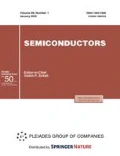Abstract
Electrostatics is used to model the narrowing of the energy gap ɛ 2 between Hubbard bands (the A 0-and A +-bands) in a p-doped semiconductor with increasing acceptor concentration N + N 0 + N -1 + N +1 and with increasing degree of compensation K by donors for N −1≈KN. The screening of impurity ions by holes hopping from acceptor to acceptor is taken into account. It is shown that this effect leads to a shift of the A 0-band towards the valence band and the A +-band towards the conduction band. The concentration of holes hopping in the A +-band N +1 N 0/N is determined by the energy of their thermal generation ɛ 2 from the A 0-band. The values of ɛ 2 calculated for Si: B are in agreement with experimental data.
Similar content being viewed by others
References
E. M. Gershenzon, A. P. Mel’nikov, R. I. Rabinovich, and N. A. Serebryakova, Usp. Fiz. Nauk 132, 353 (1980) [Sov. Phys. Usp. 132, 153 (1980)].
H. Nushimura, Phys. Rev. 138, A815 (1965).
L. P. Ginzburg, Fiz. Tekh. Poluprovodn. 12, 564 (1978) [Sov. Phys. Semicond. 12, 326 (1978)].
E. M. Gershenzon, F. M. Ismagilova, and L. B. Litvak-Gorskaya, Fiz. Tekh. Poluprovodn. 28, 671 (1994) [Semiconductors 28, 401 (1994)].
J. Bethin, T. G. Castner, and N. K. Lee, Solid State Commun. 14, 1321 (1974).
Semiconductors: Group IV Elements and III–V Compounds, edited by O. Madelung (Springer-Verlag, Berlin-Heidelberg, 1991), p. 164.
T. M. Lifshits, Instrum. Exp. Tech., No. 1 10 (1993).
D. E. Phelps and K. K. Bajaj, Phys. Rev. B 26, 912 (1982).
N. A. Poklonski, V. F. Stelmakh, V. D. Tkachev, and S. V. Voitikov, Phys. Status Solidi B 88, K165 (1978).
V. S. Bonch-Bruevich and S. G. Kalashnikov, Semiconductor Physics [in Russian], Nauka, Moscow (1990), ch. 5, p. 189.
N. A. Poklonski, and A. I. Syaglo, Fiz. Tverd. Tela (St. Petersburg) 40, 147 (1998) [Phys. Solid State 40, 51 (1998)].
N. A. Poklonskii and A. I. Syaglo, Abstracts of the Proceedings 3rd All-Russia Conf. in Semiconductor Physics [in Russian], FIAN, Moscow (1997), p. 117.
N. A. Poklonski and V. F. Stelmakh, Phys. Status Solidi B 117, 93 (1983).
F. M. Ismagilova, L. B. Litvak-Gorskaya, G. Ya. Lugovaya, and I. E. Trofimov, Fiz. Tekh. Poluprovodn. 25, 225 (1991) [Sov. Phys. Semicond. 25, 132 (1991)].
E. M. Gershenzon, Yu. A. Gurvich, A. P. Mel’nikov, L. N. Shestakov, Fiz. Tekh. Poluprovodn. 25, 160 (1991) [Sov. Phys. Semicond. 25, 95 (1991)].
Author information
Authors and Affiliations
Additional information
Fiz. Tekh. Poluprovodn. 33, 402–404 (April 1999)
Rights and permissions
About this article
Cite this article
Poklonskii, N.A., Syaglo, A.I. Electrostatic model of the energy gap between Hubbard bands for boron atoms in silicon. Semiconductors 33, 391–393 (1999). https://doi.org/10.1134/1.1187700
Received:
Accepted:
Issue Date:
DOI: https://doi.org/10.1134/1.1187700



